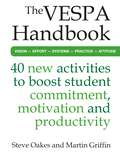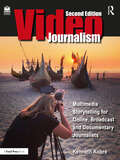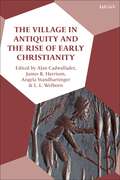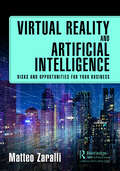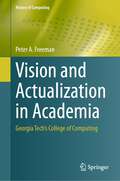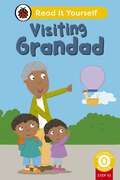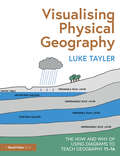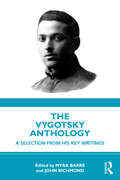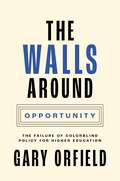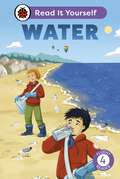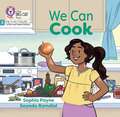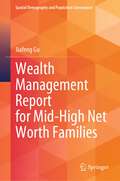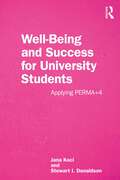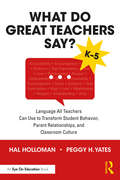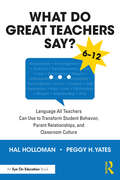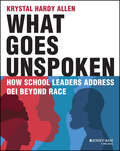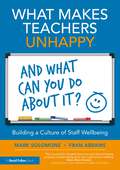- Table View
- List View
The VESPA Handbook: 40 new activities to boost student commitment, motivation and productivity
by Steve Oakes Martin GriffinOffers 40 concrete, practical tools and activities that will supercharge learners' ambition, organisation, persistence and determination. Where some education books focus on how individual teachers might sequence and deliver pieces of information in the clearest, most helpful and supportive way, engaging as many learners as possible, this one is different. This book looks at how you can help learners manage their workload and take control of their own knowledge and skills. It explores the characteristics, qualities and habits of successful students and shares forty replicable tools and tactics that all students can use immediately, both in and out of the classroom – activities that will help them to set goals, work more efficiently, organise their resources, revise more effectively and solve problems. This book is a perfect introduction to the VESPA approach, as well as being a practical addition to previous resources. The VESPA Handbook will help teachers develop the five key characteristics and behaviours that students need to be successful: vision, effort, systems, practice and attitude. When it comes to achieving academic success, these characteristics are crucial. Suitable for teachers, tutors and parents who want to boost academic outcomes in 14–18-year-olds and equip them with powerful tools and techniques in preparation for further education and employment.
Videojournalism: Multimedia Storytelling for Online, Broadcast and Documentary Journalists
by Kenneth KobreVideojournalism: Multimedia Storytelling for Online, Broadcast and Documentary Journalists is an essential guide for solo video storytellers—from "backpack" videojournalists to short-form documentary makers to do-it-all broadcast reporters.Based on interviews with award-winning professionals sharing their unique experiences and knowledge, Videojournalism covers topics such as crafting and editing eye-catching short stories, recording high-quality sound, and understanding the laws and ethics of filming in public and private places. Other topics include:• understanding the difference between a story and a report• finding a theme and telling a story in a compact time frame• learning to use different cameras and lenses—from smart phones to mirrorless and digital cinema cameras• using light, both natural and artificial • understanding color and exposureThe second edition of this best-selling text has been completely revised and updated. Heavily illustrated with more than 550 photographs, the book also includes more than 200 links to outstanding examples of short-form video stories. Anatomy of a News Story, a short documentary made for the book, follows a day in the life of a solo TV videojournalist on an assignment (with a surprise ending), and helps readers translate theory to practice.This book is for anyone learning how to master the art and craft of telling real, short-form stories with words, sound, and pictures for the Web or television.A supporting companion website links to documentaries and videos, and includes additional recommendations from the field’s most prominent educators.
Videojournalism: Multimedia Storytelling for Online, Broadcast and Documentary Journalists
by Kenneth KobreVideojournalism: Multimedia Storytelling for Online, Broadcast and Documentary Journalists is an essential guide for solo video storytellers—from "backpack" videojournalists to short-form documentary makers to do-it-all broadcast reporters.Based on interviews with award-winning professionals sharing their unique experiences and knowledge, Videojournalism covers topics such as crafting and editing eye-catching short stories, recording high-quality sound, and understanding the laws and ethics of filming in public and private places. Other topics include:• understanding the difference between a story and a report• finding a theme and telling a story in a compact time frame• learning to use different cameras and lenses—from smart phones to mirrorless and digital cinema cameras• using light, both natural and artificial • understanding color and exposureThe second edition of this best-selling text has been completely revised and updated. Heavily illustrated with more than 550 photographs, the book also includes more than 200 links to outstanding examples of short-form video stories. Anatomy of a News Story, a short documentary made for the book, follows a day in the life of a solo TV videojournalist on an assignment (with a surprise ending), and helps readers translate theory to practice.This book is for anyone learning how to master the art and craft of telling real, short-form stories with words, sound, and pictures for the Web or television.A supporting companion website links to documentaries and videos, and includes additional recommendations from the field’s most prominent educators.
The Village in Antiquity and the Rise of Early Christianity
by Alan H. Cadwallader, James R. Harrison,Angela Standhartinger and L. L. WelbornA complete geographical and thematic overview of the village in an antiquity and its role in the rise of Christianity. The volume begins with a “state-of-question” introduction by Thomas Robinson, assessing the interrelation of the village and city with the rise of early Christianity. Alan Cadwallader and James R. Harrison then articulate a methodology for future New Testament studies on this topic, employing a series of case studies to illustrate the methodological issues raised.From there contributors explore three areas of village life in different geographical areas, by means of a series of studies, written by experts in each discipline. They discuss the ancient near east (Egypt and Israel), mainland and Isthmian Greece, Asia Minor, and the Italian Peninsula. This geographic focus sheds light upon the villages associated with the biblical cities (Israel; Corinth; Galatia; Ephesus; Philippi; Thessalonica; Rome), including potential insights into the rural nature of the churches located there.A final section of thematic studies explores central issues of local village life (indigenous and imperial cults, funerary culture, and agricultural and economic life).
Virtual Reality and Artificial Intelligence: Risks and Opportunities for Your Business
by Matteo ZaralliTechnology is rapidly transforming the way people learn and train, and the integration of virtual reality (VR) and artificial intelligence (AI) could be the next big breakthrough. With the advent of Web 3.0 and the Metaverse, there are endless possibilities for creating immersive and engaging learning environments. However, there is also a need to address the risks and challenges that these technologies present.This book explores the risks and opportunities of VR and AI for coaching and training, with an eye toward the emerging trends of Web 3.0 and the Metaverse. Coaching and training have become increasingly important for companies seeking to develop and retain talent. With the advent of VR and AI technology, there is an opportunity to create immersive and engaging learning environments that could greatly enhance the learning experience. However, there are also risks associated with the use of these technologies, such as data privacy and cybersecurity.This book provides an in-depth analysis of the risks and opportunities of VR and AI for coaching and training, to help startup and business executives understand how to use these technologies responsibly and effectively. We need a new perspective. The book discusses the intersection of various major subjects and topics: business, innovation, technology, and philosophy in terms of critical thinking. The transition we are experiencing through this new Intelligent Revolution is very important, and soon everyone will witness the shift from e-learning to v-learning.
Virtual Reality and Artificial Intelligence: Risks and Opportunities for Your Business
by Matteo ZaralliTechnology is rapidly transforming the way people learn and train, and the integration of virtual reality (VR) and artificial intelligence (AI) could be the next big breakthrough. With the advent of Web 3.0 and the Metaverse, there are endless possibilities for creating immersive and engaging learning environments. However, there is also a need to address the risks and challenges that these technologies present.This book explores the risks and opportunities of VR and AI for coaching and training, with an eye toward the emerging trends of Web 3.0 and the Metaverse. Coaching and training have become increasingly important for companies seeking to develop and retain talent. With the advent of VR and AI technology, there is an opportunity to create immersive and engaging learning environments that could greatly enhance the learning experience. However, there are also risks associated with the use of these technologies, such as data privacy and cybersecurity.This book provides an in-depth analysis of the risks and opportunities of VR and AI for coaching and training, to help startup and business executives understand how to use these technologies responsibly and effectively. We need a new perspective. The book discusses the intersection of various major subjects and topics: business, innovation, technology, and philosophy in terms of critical thinking. The transition we are experiencing through this new Intelligent Revolution is very important, and soon everyone will witness the shift from e-learning to v-learning.
Vision and Actualization in Academia: Georgia Tech’s College of Computing (History of Computing)
by Peter A. FreemanAlthough difficult, change in academic structures is necessary today, especially in fast-changing fields today such as biology, computing, management, the social sciences, and others. This includes changes within existing organizations as well as creation of new structures and reorganizations or eliminations of older ones. This narrative attempts first to document the historical rise of an organization, Georgia Tech’s College of Computing, that has touched and successfully changed the lives of thousands of people. Second, it aims to identify and explicate some of what has led to this widely acknowledged success. The book provides a chronological narrative that highlights major changes taken under each successive leader. These changes have built on one another, knowingly or otherwise, to create a growing organization that rivals in size and prominence longer established parts of the university. The case study, while of an academic organization focused on computing, provides general lessons applicable almost anywhere. Topics and features: Discusses the nature and uses of visions, both general and specificShows how visions can be used to drive specific actions and resource allocationsIllustrates the choice and use of enduring organizational principlesOutlines a simple strategic-planning method and its applicationIndicates results of this overall approach This book will be of interest to anyone interested in organizational change, especially in academia, and to those interested in Georgia Tech. It will also appeal to policymakers in education, government, and industry; as well as anyone interested in the historical growth of the computing milieu broadly. Peter A. Freeman was Founding Dean and Professor in the College of Computing at Georgia Tech from 1990 to 2002. Today he is an Emeritus Dean and Professor.
Visiting Grandad (Read It Yourself)
by LadybirdTwo stories that build on the phonics learned in previous steps and practise sound and letter combinations that have already been encountered.Visiting Grandad is from Beginner Reader Level 0 and is ideal for children aged from 4+ who are developing their phonics and early reading skills.Each book has been carefully checked by educational and subject consultants and includes comprehension puzzles, book band information, and tips for helping children with their reading.With five levels to take children from first phonics to fluent reading and a wide range of different stories and topics for every interest, Read It Yourself helps children build their confidence and begin reading for pleasure.
Visualising Physical Geography: The How and Why of Using Diagrams to Teach Geography 11–16
by Luke TaylerThis practical guide breaks down the complex and broad field of physical geography, demonstrating how diagrams can be used by teachers to effectively explain the key concepts behind many natural processes and landforms. Featuring over 200 diagrams that cover the key topics taught in Key Stage 3 and 4 Geography, the book shows teachers how they can convey age-appropriate concepts without overwhelming or oversimplifying.Supported by summaries of background knowledge, common misconceptions, questions to check understanding, and extension activities, the concepts and topics explored include: Rocks and weathering Plate tectonics Rivers Coasts Weather and climate Ecosystems Glaciation Backed by research and evidence to support the use of diagrams in the classroom, this is an essential read for any geography teacher or subject lead who wants to support their students in learning key concepts in physical geography.
Visualising Physical Geography: The How and Why of Using Diagrams to Teach Geography 11–16
by Luke TaylerThis practical guide breaks down the complex and broad field of physical geography, demonstrating how diagrams can be used by teachers to effectively explain the key concepts behind many natural processes and landforms. Featuring over 200 diagrams that cover the key topics taught in Key Stage 3 and 4 Geography, the book shows teachers how they can convey age-appropriate concepts without overwhelming or oversimplifying.Supported by summaries of background knowledge, common misconceptions, questions to check understanding, and extension activities, the concepts and topics explored include: Rocks and weathering Plate tectonics Rivers Coasts Weather and climate Ecosystems Glaciation Backed by research and evidence to support the use of diagrams in the classroom, this is an essential read for any geography teacher or subject lead who wants to support their students in learning key concepts in physical geography.
The Vygotsky Anthology: A Selection from His Key Writings
by Myra Barrs John RichmondThe Vygotsky Anthology brings together, for the first time, a selection of extracts from the best translations available of Vygotsky’s writings, spanning the entire arc of his career.Vygotsky was arguably one of the greatest educational psychologists of the 20th century. Grounded in his experience as a teacher, an expert in special education, a research psychologist and an outstanding theorist, the editors of this unique anthology chart his enormous influence on professionals working in education and child development around the world. The extracts are introduced by the editors’ commentaries, helpfully setting them in the context of Vygotsky’s life and work, providing a collection of work that adequately represents his writing, and conveying some of the great pleasures of reading him. In the passages selected here, his voice is clearly heard, the intellectual brilliance of his insights is reflected, his line of argument is clear, and his humour and humanity are evident.With its inclusion of recent translations of essential texts, this anthology will help students to understand the full diversity of Vygotsky’s influence on today’s classrooms. Seen as a companion volume to Myra Barrs’ previous work Vygotsky the Teacher (Routledge, 2022), the value of this text to teachers, educational psychologists, and other practitioners working in the field of education and child development will be significant and lasting. It is a key reference book for new generations of Vygotsky students.
The Vygotsky Anthology: A Selection from His Key Writings
The Vygotsky Anthology brings together, for the first time, a selection of extracts from the best translations available of Vygotsky’s writings, spanning the entire arc of his career.Vygotsky was arguably one of the greatest educational psychologists of the 20th century. Grounded in his experience as a teacher, an expert in special education, a research psychologist and an outstanding theorist, the editors of this unique anthology chart his enormous influence on professionals working in education and child development around the world. The extracts are introduced by the editors’ commentaries, helpfully setting them in the context of Vygotsky’s life and work, providing a collection of work that adequately represents his writing, and conveying some of the great pleasures of reading him. In the passages selected here, his voice is clearly heard, the intellectual brilliance of his insights is reflected, his line of argument is clear, and his humour and humanity are evident.With its inclusion of recent translations of essential texts, this anthology will help students to understand the full diversity of Vygotsky’s influence on today’s classrooms. Seen as a companion volume to Myra Barrs’ previous work Vygotsky the Teacher (Routledge, 2022), the value of this text to teachers, educational psychologists, and other practitioners working in the field of education and child development will be significant and lasting. It is a key reference book for new generations of Vygotsky students.
The Walls around Opportunity: The Failure of Colorblind Policy for Higher Education (Our Compelling Interests #8)
by Gary OrfieldThe case for race-conscious education policyIn our unequal society, families of color fully share the dream of college but their children often attend schools that do not prepare them, and the higher education system gives the best opportunities to the most privileged. Students of color hope for college but often face a dead end.For many young people, racial inequality puts them at a disadvantage from early childhood. The Walls around Opportunity argues that colorblind policies have made college inaccessible to a large share of students of color, and reveals how policies that acknowledge racial inequalities and set racial equality goals can succeed where colorblindness has failed.Gary Orfield paints a troubling portrait of American higher education, explaining how profound racial gaps imbedded in virtually every stage of our children&’s lives pose a major threat to communities of color and the nation. He describes how the 1960s and early 1970s was the only period in history to witness sustained efforts at racial equity in higher education, and how the Reagan era ushered in today&’s colorblind policies, which ignore the realities of color inequality. Orfield shows how this misguided policy has resegregated public schools, exacerbated inequalities in college preparation, denied needed financial aid to families, and led to huge price increases over decades that have seen little real gain in income for most Americans.Now with a new afterword that discusses the 2023 Supreme Court decision to outlaw affirmative action in college admissions, this timely and urgent book shows that the court&’s colorblind ruling is unworkable in a society where every aspect of opportunity and preparation is linked to race, and reveals the gaps in the opportunity pipeline while exploring the best ways to address them in light of this decision.
Water: Read It Yourself - Level 4 Fluent Reader (Read It Yourself)
by LadybirdHumans, animals, and plants need water every day to survive. But where does it come from? How do we know if it is safe to drink? Learn all about how water is saved, cleaned, and shared in this fact-filled book. Water is from Fluent Reader Level 4 and is ideal for more fluent readers aged from 7+ who are starting to read independently.Each book has been carefully checked by educational and subject consultants and includes comprehension puzzles, book band information, and tips for helping children with their reading. With five levels to take children from first phonics to fluent reading and a wide range of different stories and topics for every interest, Read It Yourself helps children build their confidence and begin reading for pleasure.
We Can Cook: Phase 3 Set 2 (Big Cat Phonics For Little Wandle Letters And Sounds Revised Ser.)
by Sophia Payne Sayada Ramdial Collins Big CatWealth Management Report for Mid-High Net Worth Families (Spatial Demography and Population Governance)
by Jiafeng GuThis book analyzes the wealth management of mid-high net worth individuals and families. As China's economy develops and people's living standards improve, more and more families are becoming well-off and the middle-income group continues to expand. After creating wealth and becoming rich, better guarding, spreading and enjoying wealth is not only an urgent challenge faced by more and more micro-families, but also an inevitable need to enrich and energize people's livelihood and the connotation of a good life.Mid-high net worth people are an organic part of China's middle-income group, as well as the future coordinates of many families that have just crossed into the middle-income group. An accurate portrait of this group and an in-depth study of the needs, habits, ways and effects of their family wealth management and distribution are conducive to better responding to the demands of affluent families to "keep, pass on and enjoy wealth," as well as exploring the path of solidly promoting common prosperity at the micro-family level. From this perspective, Institute of Social Science Survey of Peking University has conducted a panoramic analysis on mid-high net worth people from panel survey with more 16,000 households in China after 10 years of tracking and investigation, from six aspects: behavioral patterns, financial asset allocation, non-financial asset allocation, commercial insurance allocation, children's commercial medical insurance allocation and pension insurance allocation, the importance of which is self-evident. As the first systematic work on asset allocation and insurance protection of Chinese middle and high net worth families, although part of the purpose is to explore the demand for insurance protection and develop the commercial insurance market, there is no doubt that this study is an important reference for the government to formulate social security policies and for financial institutions to optimize the supply of family wealth services.
Well-Being and Success For University Students: Applying PERMA+4
by Jana Koci Stewart I. DonaldsonWell-Being and Success for University Students: Applying PERMA+4 is grounded in the science of well-being and positive psychology and teaches students how to strengthen their health and well-being, as well as to make their study journey more enjoyable and successful. Higher education has changed dramatically during the last few years, and given the massive growth of mental health challenges among students, universities and faculty have recognized the need to help students to strive, not only survive. Universities have a great potential and responsibility to promote the well-being of their students. This book provides students with information, motivation, and skills to build their own unique well-being and helps colleges to produce more well-being in the university culture. Students and faculty will be introduced to PERMA+4, an evidence-based framework for enhancing well-being and positive functioning, including academic performance. This book emphasizes practical applications of findings from the best available research to have students learn several steps they can take to strengthen their well-being and academic performance. Individual chapters talk about popular topics of positive psychology such as positive emotions, engagement, relationships, meaning, achievement, physical health, mindset, environment, and economic security. Each chapter summarizes the knowledge on specific topics, invites students to assess their well-being in the particular life domain, and encourages them to explore and try activities and evidence-based interventions to learn how to care for their own mental and overall health. This book not only serves as a guide for students but also as a useful tool for professors seeking to enhance their courses and programs with well-being promotion and student wellness centers across the world.
Well-Being and Success For University Students: Applying PERMA+4
by Jana Koci Stewart I. DonaldsonWell-Being and Success for University Students: Applying PERMA+4 is grounded in the science of well-being and positive psychology and teaches students how to strengthen their health and well-being, as well as to make their study journey more enjoyable and successful. Higher education has changed dramatically during the last few years, and given the massive growth of mental health challenges among students, universities and faculty have recognized the need to help students to strive, not only survive. Universities have a great potential and responsibility to promote the well-being of their students. This book provides students with information, motivation, and skills to build their own unique well-being and helps colleges to produce more well-being in the university culture. Students and faculty will be introduced to PERMA+4, an evidence-based framework for enhancing well-being and positive functioning, including academic performance. This book emphasizes practical applications of findings from the best available research to have students learn several steps they can take to strengthen their well-being and academic performance. Individual chapters talk about popular topics of positive psychology such as positive emotions, engagement, relationships, meaning, achievement, physical health, mindset, environment, and economic security. Each chapter summarizes the knowledge on specific topics, invites students to assess their well-being in the particular life domain, and encourages them to explore and try activities and evidence-based interventions to learn how to care for their own mental and overall health. This book not only serves as a guide for students but also as a useful tool for professors seeking to enhance their courses and programs with well-being promotion and student wellness centers across the world.
What Do Great Teachers Say?: Language All Teachers Can Use to Transform Student Behavior, Parent Relationships, and Classroom Culture K-5
by Hal Holloman Peggy H. YatesDo you remember a time when you used the right words at the right moment, and they made all the difference? With the aim of helping you repeat that experience every day, this book provides hundreds of examples of what we call Great Teacher Language, a technique designed to help all teachers use words to transform student behavior and parent relationships. In their years of working at the K-12 levels, educators Hal Holloman and Peggy H. Yates have identified the exact phrases and key words you can use in your classroom to address inappropriate outbursts, a lack of respect and cooperation, student conflict, and more. Great Teacher Language will enable you to transform student behavior, parent relationships, and your classroom culture. This book features 11 Great Teacher Language Word Categories, which you'll learn how to use in terms of self-talk, student talk, and parent talk: Words of Accountability, Words of Encouragement, Words of Grace, Words of Guidance, Words of High Expectations, Words of Hope, Words of Love, Words of Relationships, Words of Respect, Words of Understanding, and Words of Unity. Filled with helpful charts and Great Teacher Language examples, this resource will be one you turn to again and again, and will make a transformational difference for your students, your parents, and you!
What Do Great Teachers Say?: Language All Teachers Can Use to Transform Student Behavior, Parent Relationships, and Classroom Culture K-5
by Hal Holloman Peggy H. YatesDo you remember a time when you used the right words at the right moment, and they made all the difference? With the aim of helping you repeat that experience every day, this book provides hundreds of examples of what we call Great Teacher Language, a technique designed to help all teachers use words to transform student behavior and parent relationships. In their years of working at the K-12 levels, educators Hal Holloman and Peggy H. Yates have identified the exact phrases and key words you can use in your classroom to address inappropriate outbursts, a lack of respect and cooperation, student conflict, and more. Great Teacher Language will enable you to transform student behavior, parent relationships, and your classroom culture. This book features 11 Great Teacher Language Word Categories, which you'll learn how to use in terms of self-talk, student talk, and parent talk: Words of Accountability, Words of Encouragement, Words of Grace, Words of Guidance, Words of High Expectations, Words of Hope, Words of Love, Words of Relationships, Words of Respect, Words of Understanding, and Words of Unity. Filled with helpful charts and Great Teacher Language examples, this resource will be one you turn to again and again, and will make a transformational difference for your students, your parents, and you!
What Do Great Teachers Say?: Language All Teachers Can Use to Transform Student Behavior, Parent Relationships, and Classroom Culture 6-12
by Hal Holloman Peggy H. YatesDo you remember a time when you used the right words at the right moment, and they made all the difference? With the aim of helping you repeat that experience every day, this book provides hundreds of examples of what we call Great Teacher Language, a technique designed to help all teachers use words to transform student behavior and parent relationships. In their years of working at the K-12 levels, educators Hal Holloman and Peggy H. Yates have identified the exact phrases and key words you can use in your classroom to address inappropriate outbursts, a lack of respect and cooperation, student conflict, and more. Great Teacher Language will enable you to transform student behavior, parent relationships, and your classroom culture.The book features 11 Great Teacher Language Word Categories, which you'll learn how to use in terms of self-talk, student talk, and parent talk: Words of Accountability, Words of Encouragement, Words of Grace, Words of Guidance, Words of High Expectations, Words of Hope, Words of Love, Words of Relationships, Words of Respect, Words of Understanding, and Words of Unity.Filled with helpful charts and Great Teacher Language examples, this resource will be one you turn to again and again and will make a transformational difference for your middle and high school students, their parents, and you!
What Do Great Teachers Say?: Language All Teachers Can Use to Transform Student Behavior, Parent Relationships, and Classroom Culture 6-12
by Hal Holloman Peggy H. YatesDo you remember a time when you used the right words at the right moment, and they made all the difference? With the aim of helping you repeat that experience every day, this book provides hundreds of examples of what we call Great Teacher Language, a technique designed to help all teachers use words to transform student behavior and parent relationships. In their years of working at the K-12 levels, educators Hal Holloman and Peggy H. Yates have identified the exact phrases and key words you can use in your classroom to address inappropriate outbursts, a lack of respect and cooperation, student conflict, and more. Great Teacher Language will enable you to transform student behavior, parent relationships, and your classroom culture.The book features 11 Great Teacher Language Word Categories, which you'll learn how to use in terms of self-talk, student talk, and parent talk: Words of Accountability, Words of Encouragement, Words of Grace, Words of Guidance, Words of High Expectations, Words of Hope, Words of Love, Words of Relationships, Words of Respect, Words of Understanding, and Words of Unity.Filled with helpful charts and Great Teacher Language examples, this resource will be one you turn to again and again and will make a transformational difference for your middle and high school students, their parents, and you!
What Goes Unspoken: How School Leaders Address DEI Beyond Race
by Krystal Hardy AllenPractical ways and tools for school leaders to operationalize diversity, equity, and inclusion What Goes Unspoken is a must-have guide for any school or educational systems leader looking to comprehend and put into play an effective, equity-centered plan that champions students, teachers, and staff. Moving beyond the abundant resources that focus on DEI theories, author Krystal Hardy Allen shows leaders and administrators how to concretely center DEI within both practices and policies, as well as how to do the interpersonal work of becoming a self-aware and equity-focused leader. With these resources, you'll learn how to ensure that DEI is embedded in your strategic planning to create schools and education organizations that are transformative, inclusive, and equitable for both children and adults. Focusing on ten specific domains of school leadership and district operations—including school board governance, finance, community engagement, instruction, school culture, and more—this book shows you exactly how to shift from theory to action. Instead of investing thousands of dollars in trainings and initiatives that are often piecemeal, abstract, or at times ineffective, it's essential that that leaders learn practical steps to advance diversity, equity, and inclusion at the district, school, and classroom levels. Drawing on her own school leadership and international educational consultant experience, Allen teaches you to: Better understand your role as a leader within your school or district's DEI work and how the intrapersonal work you do influences your decisions Prioritize an equity-informed view, policies, and practices within different areas of teacher development, school operations and finance, parent engagement, student culture, school board governance, marketing and branding, and more Clarify the relationship between DEI and your schools' or district's mission, vision, values, and goals Build an effective strategic plan at the school or district level that provides both guidance and accountability to your school or district's DEI journey In the current cultural and sociopolitical climate, What Goes Unspoken is a must-read for leaders and administrators of public and private schools, as well as district personnel and educational leadership training programs.
What Goes Unspoken: How School Leaders Address DEI Beyond Race
by Krystal Hardy AllenPractical ways and tools for school leaders to operationalize diversity, equity, and inclusion What Goes Unspoken is a must-have guide for any school or educational systems leader looking to comprehend and put into play an effective, equity-centered plan that champions students, teachers, and staff. Moving beyond the abundant resources that focus on DEI theories, author Krystal Hardy Allen shows leaders and administrators how to concretely center DEI within both practices and policies, as well as how to do the interpersonal work of becoming a self-aware and equity-focused leader. With these resources, you'll learn how to ensure that DEI is embedded in your strategic planning to create schools and education organizations that are transformative, inclusive, and equitable for both children and adults. Focusing on ten specific domains of school leadership and district operations—including school board governance, finance, community engagement, instruction, school culture, and more—this book shows you exactly how to shift from theory to action. Instead of investing thousands of dollars in trainings and initiatives that are often piecemeal, abstract, or at times ineffective, it's essential that that leaders learn practical steps to advance diversity, equity, and inclusion at the district, school, and classroom levels. Drawing on her own school leadership and international educational consultant experience, Allen teaches you to: Better understand your role as a leader within your school or district's DEI work and how the intrapersonal work you do influences your decisions Prioritize an equity-informed view, policies, and practices within different areas of teacher development, school operations and finance, parent engagement, student culture, school board governance, marketing and branding, and more Clarify the relationship between DEI and your schools' or district's mission, vision, values, and goals Build an effective strategic plan at the school or district level that provides both guidance and accountability to your school or district's DEI journey In the current cultural and sociopolitical climate, What Goes Unspoken is a must-read for leaders and administrators of public and private schools, as well as district personnel and educational leadership training programs.
What Makes Teachers Unhappy, and What Can You Do About It? Building a Culture of Staff Wellbeing
by Mark Solomons Fran AbramsMany teachers, support staff and school leaders are tired, stressed and overstretched. And even though this frequently makes the headlines, it isn’t a new problem. In this book, Mark Solomons and Fran Abrams argue staff wellbeing should be rooted in the culture and climate of our schools. They provide a roadmap to recovery for struggling schools which should lead to improvements in staff morale, workload management and mental wellbeing. With a range of real-life examples, this book focuses on how school leaders can build workplace wellbeing in even the most challenging environments. It includes clear links to research evidence and summaries of the key steps necessary to deal with common issues such as: Identifying and mapping issues in your school Leading for wellbeing Creating and maintaining a happy workforce Developing a culture of everyday wellbeing Overseeing change. Written in an entertaining yet informative manner, this is the go-to guide for school leaders who want to support staff by building a more positive and supportive workplace.
